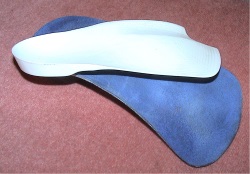All Orthoses Are Not Created Equal
Many different kinds of in-shoe devices are referred to as “orthoses”. You’ll see orthoses in television commercials, stands at consumer shows and in a growing number of retail shops. Arch supports and insoles sold in pharmacies, sports and shoe shops are increasingly referred to as “orthotics”.

Then there are the orthoses that Podiatrists and related professionals prescribe for their patients. For most consumers, telling the difference between the various types of Orthoses (and making an informed decision) is a challenge. Recognising slick sales “spin” and separating it from the facts can be an even bigger challenge.
Following is some information that may help. There are three common types of foot orthoses: Custom, Customised, and Off-the-Shelf.
Custom
Custom foot Orthoses are prescription medical devices, designed to adjust and control the functions of the foot and its alignment with the lower leg.
They are used to treat/prevent injury-causing motions including excessive pronation (collapsing in) and supination (rolling out) and make standing, walking and running more efficient. Some custom orthoses are designed to redistribute pressure on the bottoms of the feet alleviating pain from corns, calluses or bony prominences.
Genuine, custom foot Orthoses are made by starting with a thorough exam by a qualified health care professional, followed by the taking of impressions using plaster or an impression foam material, followed by the completion of a detailed prescription form. Casts and prescription are then sent to a professional Lab where the orthoses are made by technicians with appropriate training and qualifications.
Customised
Customised devices are relatively new in the market and can be difficult to distinguish from genuine custom ones. They are commonly a product of computerised force platform systems that capture and display pressure information and are typically made by adding components to a pre-manufactured insole. Unfortunately, they are often marketed as “custom” and sold at similar prices. One way to tell the difference between custom and customised is if a plaster cast or foam impression is not taken of your feet, you won’t be getting genuine custom orthoses.
Walking or standing on a force platform form with a colourful graphic display is an excellent way to evaluate some aspects of foot function and pressure distribution. In qualified hands, force platforms can be useful diagnostic tools but they are incapable of capturing true, three-dimensional volumetric impressions of the feet. Beware of the slick sales “spin” - if there is no cast, it will not be custom.
Off-the-shelf
Off-the-Shelf devices are most commonly found in retail pharmacies, sports and shoe shops as well as some specialty shops. Some foot health care professionals recommend them for minor foot problems. They rarely cost more than £15.00 - £40.00 and the better quality ones can provide a good measure of arch support and cushioning.
Want to know if Orthoses are right for you?
Start by consulting your local Podiatrist
Getting orthoses that are right for you begins with a thorough examination by a qualified Podiatrist. You won’t find these people on television, in the shopping centre or at a consumer show. Minor foot problems can often be treated with an inexpensive off-the-shelf insole and/or proper footwear selection and fitting advice. More pronounced/persistent problems usually require a more precise, custom Orthotic solution.
Podiatric Biomechanics
Podiatric biomechanics relates to the study of Human mechanical motion in relationship to the problems that are either directly related to foot pain or how foot mechanics may have influenced the cause of other postural problems or have maintained or reduced the ability of the body to heal these injuries usually in the lower limb and back.
Treatments are usually a combination of mechanical control of the foot. Initially often involving strapping or padding. Then specially designed insoles (Orthotics) which alters how the foot works influencing the movement of the knees, hips and lower back. This combination allows healing, or helps the foot and limb work in a more functional position, preventing further injury. Rehabilitation exercises are also very important depending on your problem may also involve working with Physiotherapists, Osteopaths or Chiropractors.
To help achieve these results detailed evaluations are made as to how the injured area is influenced by the body’s mechanical and medical function. This will involve assessing the range of motion of joints. Checking for muscle imbalances and assessing the nerve and blood supply. As well as an overall review of your general health, past injuries, previous treatments and medication used.
Specialist Tests

Depending on the severity, location of pain or injury. Consideration will be given to using the following
- X rays
- Diagnostic Ultrasound
- MRI or CT scans
- Blood tests
These tests are used to see the exact location and extent of the problem.
Watching the body working is very important. Gait analysis is used (sometimes with a treadmill) and may involve a video so the motion may be slowed down to review specific actions that occur to quickly for the human eye to see. This allows us to measure exact range of foot and limb movement.
Dynamic Pressure and Gait Analysis (F Scan)

This diagnostic test is used to observe how the foot is placed on the ground showing how the pressures and forces are taken by the foot. This test also identifies how foot joints may be not working efficiently therefore resulting in restricting or increasing desired motion.
Dynamic analysis also indicates how walking and running may be altering the centre of gravity, influencing abnormalities and forces on the rest of the body. For specific sports these tests may be undertaken within a sports facility.

What to wear and bring with you for the tests
If a sports related problem please bring with you sportswear, i.e. shorts and T-shirt, footwear must include trainers and normal day shoes.
For non sports problems loose fitting clothes that can be rolled above the knees.
*Bio-mechanic tests can not be done in Sandals or high boots (Apart from Walking boots)
